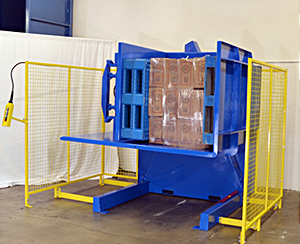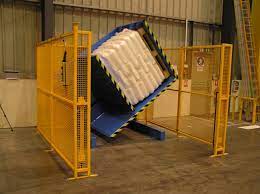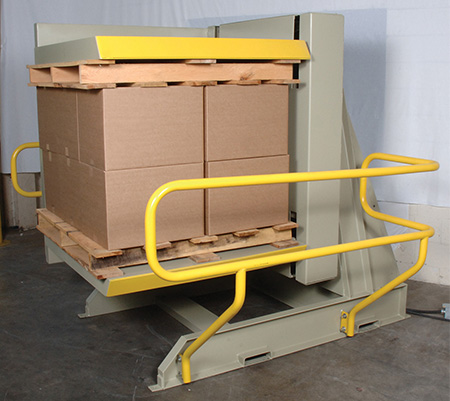90° vs 180°: Which Mold Flipper is Better for Your Mold Maintenance Scenarios?
Choosing the right equipment for your facility can feel like a high-stakes decision. You know that a mold flipper will improve safety and efficiency in your maintenance bay, but the options seem confusing. You might worry about making the wrong choice, investing in a machine that is either overkill for your needs or, worse, can't handle your most critical tasks. This indecision can lead to delays, sticking with inefficient and unsafe manual methods that cost you time and put your team at risk. As an engineer who has built these machines and helped countless factories optimize their workflow, I want to give you a clear, practical guide to help you select the perfect mold flipper for your specific operation.
The best choice between a 90° and a 180° mold flipper depends entirely on your maintenance workflow, workshop layout, and the complexity of your molds. A 90° mold flipper is ideal for quick inspections, cleaning, and one-sided repairs. A 180° mold flipper is necessary for comprehensive overhauls and any work that requires easy access to both halves of the mold.

I've spent over 25 years in the packaging and material handling industry, from my early days on the factory floor to establishing my own company, SHJLPACK. This journey has taught me that the "best" machine is simply the one that solves your problem most effectively. A decision like this isn't just about the machine's turning angle; it's about optimizing your entire maintenance process, reducing downtime, and ensuring the safety of your people. Let’s break down the differences and applications of these two powerful tools so you can make an informed decision that pays dividends for years to come.
What are the key differences between a 90° and a 180° mold flipper?
You might be looking at spec sheets for both 90° and 180° mold flippers, and they might seem functionally similar. They both take a large, heavy mold and turn it. This can make it difficult to justify the potential price difference or understand the specific advantages of one over the other. If you choose incorrectly, you could end up with a machine that either slows down your workflow or can't perform the operations you need most, forcing you back to using overhead cranes in a way that is slow and risky. Let's clear up the confusion and look at what truly separates these two machines.
The key difference lies in their final orientation and purpose. A 90° flipper turns a mold onto its side, providing vertical access for tasks like cleaning or inspection. In contrast, a 180° flipper completely inverts the mold, allowing technicians to work on the bottom half as if it were the top, which is essential for comprehensive repairs and assembly.

To truly understand which machine fits your needs, we need to go beyond the simple turning angle. As an engineer, I always look at the mechanics, the intended application, and the impact on the overall process. For a plant manager or owner like yourself, these details translate directly into uptime, labor costs, and safety records. Let's dive deeper into the core distinctions.
Functional Purpose
The most fundamental difference is the job each machine is designed to do.
- 90° Mold Flipper: Its primary purpose is to move a mold from a horizontal to a vertical position. Think of it as standing a book up on its end. This is perfect for tasks where you need access to the side of the mold or want to open the two halves while it's held securely in a vertical orientation. It is often used for inspection of parting lines, cleaning mold cavities, and performing minor repairs on one accessible face.
- 180° Mold Flipper: This machine is built for a complete turnover. It takes a mold and flips it upside down. This is critical when you need to work on what was originally the bottom of the mold. Tasks like replacing core components, servicing the entire mold half, or performing complex assembly require this full inversion. It eliminates the need to lift the mold off, have a crane turn it over in mid-air, and then place it back down—a process that is both time-consuming and hazardous.
Mechanical Structure and Operation
The mechanics behind each flip dictate the machine's footprint, complexity, and cost. I’ve seen many designs over the years, and the principle remains consistent.
- 90° Flipper: These are typically simpler in design. They often use a powerful hydraulic cylinder or a gear-motor system to tilt a single platform. The structure is robust but focused on a one-way tilting motion. The center of gravity shift is significant, so the base must be extremely stable.
- 180° Flipper: These machines are more complex. Many designs use two platforms that clamp the mold securely. The rotation is often driven by a heavy-duty chain and sprocket system or a large slewing ring gear, ensuring a smooth and controlled 180° turn. This dual-platform design provides superior stability throughout the entire motion, as the mold's center of gravity is carefully managed.
Here is a table to summarize the core differences:
| Feature | 90° Mold Flipper | 180° Mold Flipper |
|---|---|---|
| Primary Function | Tilting to a vertical position (90°) | Complete inversion (180°) |
| Best Use Case | Inspection, cleaning, one-sided repairs | Full overhaul, two-sided assembly and repairs |
| Mechanical Design | Simpler, often single-platform with tilt mechanism | More complex, often dual-platform with full rotation |
| Workflow Impact | Speeds up access to mold sides | Eliminates dangerous crane flips for bottom-side work |
| Typical Cost | Lower initial investment | Higher initial investment |
Understanding these distinctions is the first step. Now, let’s connect them to the real-world scenarios you face in your plant every day.
When is a 90° mold flipper the superior choice for my workshop?
You are constantly evaluating investments and looking for the best return. You know you need to improve your mold maintenance process, but you also face tight budgets and limited floor space. The thought of buying a large, complex machine that you might not fully utilize is a real concern. This can lead to sticking with the status quo, even when you know it's inefficient. I've worked with many clients who faced this exact dilemma. They needed a solution, but it had to be the right-sized solution.
A 90° mold flipper is the superior choice when your maintenance routine primarily involves tasks that require vertical access to the mold, such as cleaning parting lines, inspecting for wear, or performing minor repairs on one side. It is also the ideal solution if you are working with a limited budget and constrained floor space.

Let's look at the practical situations where this machine isn't just a good choice, but the smartest one. The goal is to solve your most frequent problems efficiently without over-investing in capabilities you don't need. My philosophy has always been to match the tool to the task, and a 90° flipper is a specialized tool that excels in specific, common scenarios.
Optimizing for Routine Inspection and Cleaning
In any high-volume production environment, like a steel mill that produces millions of tons annually, routine maintenance is key to preventing major failures. Most of this work is preventative.
- Parting Line Maintenance: The most frequent task is often cleaning and inspecting the parting line where the two mold halves meet. A 90° flipper allows you to open the mold like a book, giving your technicians safe, ergonomic access to clean residue, check for damage, and perform minor polishing. Doing this with an overhead crane and manual blocking is slow and exposes workers to crush hazards. The 90° flipper makes this daily or weekly task fast and secure.
- Side Component Access: Many molds have slides, lifters, or cooling channels with connections on the sides. Tilting the mold 90° provides direct, ground-level access to these components without requiring ladders or man-lifts. This drastically reduces the time needed for changeovers or repairs.
A Space-Saving and Cost-Effective Solution
For a practical business leader, every square meter of floor space and every dollar of capital expenditure must be justified.
- Smaller Footprint: 90° mold flippers generally have a more compact design compared to their 180° counterparts. In a crowded workshop where space is at a premium, this can be a deciding factor. They can be placed in a dedicated maintenance cell without disrupting major traffic flow.
- Lower Initial Investment: Due to their simpler mechanical design, 90° flippers are more affordable. If your analysis shows that 80% of your maintenance tasks can be accomplished with a 90° tilt, it makes sound financial sense to choose this option. You solve your biggest problem without paying for features you'll rarely use. I once advised a client in the automotive stamping industry. They were considering a 180° machine, but after we analyzed their maintenance logs, we found that 9 out of 10 tasks were cleaning and inspection. They chose a 90° flipper and used the capital they saved to invest in predictive maintenance sensors, a decision that provided a much higher overall return.
This targeted approach ensures you get the maximum benefit for your investment, directly addressing the goals of reducing costs and improving efficiency.
Under what conditions should I invest in a 180° mold flipper?
Your challenges are complex. You run a massive operation with aging equipment, and downtime on a key production line can have huge financial consequences. When a large, critical mold needs a complete overhaul, you can't afford a slow, inefficient, or unsafe process. Trying to perform complex repairs on both halves of a mold using only overhead cranes is a logistical nightmare. It involves multiple, risky lifts and turns, wasting valuable hours and putting your most expensive assets—both your molds and your people—at risk.
You should invest in a 180° mold flipper when your operations involve frequent, comprehensive mold overhauls, repairs that require access to both the cavity and core sides, or the assembly of complex molds. It is a necessity for maximizing safety and efficiency in heavy-duty maintenance scenarios.

In my experience, especially in heavy industries like steel manufacturing, the 180° flipper is not a luxury; it's a strategic asset. It directly tackles the most challenging and time-consuming aspects of mold maintenance. For a leader focused on long-term stability and ROI, this is where the investment truly pays off.
Enabling Comprehensive Mold Overhauls
Some jobs are more than just a simple cleaning. When you need to rebuild a mold, a 180° flipper is indispensable.
- Working on Both Halves: Imagine your team needs to work on the cooling channels on one side and the ejector pin system on the other. With a 90° flipper, you would have to tilt it, work on one side, close it, lower it, have a crane carefully flip it over, place it back on the machine, and then open it again. This process could take hours and involves multiple risky maneuvers. A 180° flipper does this in one smooth, controlled motion. It flips the entire mold, presenting the other side ready for work in minutes.
- Heavy Component Replacement: For tasks like replacing a large mold core or insert, the 180° flipper provides a stable, flat platform. Technicians can use a small auxiliary crane or lifting device to work directly on the mold without the instability or access issues of a vertically oriented mold. This is crucial for precision work that ensures the quality and longevity of the repair.
A Strategic Investment in Safety and Uptime
For a CEO managing a 2-million-ton steel plant, safety and uptime are not just metrics; they are the foundation of the business.
- Eliminating Dangerous Crane Lifts: The single most dangerous part of traditional mold maintenance is flipping the mold in mid-air with chains and an overhead crane. A sudden shift in the center of gravity can lead to a catastrophic drop. A 180° mold flipper completely eliminates this step for two-sided work. The mold is secured to the machine from start to finish. This single safety improvement can justify the entire investment.
- Drastically Reducing Turnaround Time: By streamlining the flipping process from hours to minutes, the 180° flipper directly increases your maintenance capacity and reduces equipment downtime. If a faster mold overhaul gets a critical production line running 8 hours sooner, the machine can pay for itself very quickly. This directly supports your goal of raising equipment effective run time to 95%. This is the kind of forward-thinking investment that separates industry leaders from the rest.
How do safety and efficiency compare between the two types of mold flippers?
As a leader, every decision you make is weighed against its impact on safety and operational efficiency. You know that an accident can halt production and damage morale, while an inefficient process bleeds money and slows growth. When comparing a 90° and 180° mold flipper, you're not just choosing a machine; you're designing a workflow. You might wonder if the added complexity of a 180° flipper introduces new risks, or if the simplicity of a 90° flipper creates efficiency bottlenecks. Let's put them side-by-side from a practical, engineering standpoint.
Both flippers are vastly safer than manual methods. However, for complex, two-sided maintenance, the 180° flipper offers superior safety and efficiency by eliminating dangerous mid-air crane flips. The 90° flipper is highly efficient and safe for its specific tasks of inspection and one-sided work, but becomes a bottleneck if two-sided access is required.

Having designed and deployed these systems, I've seen firsthand how the right choice can transform a maintenance bay from a high-risk bottleneck into a streamlined, safe, and productive environment. The comparison isn't about which is "better" in a vacuum, but which is optimal for a given set of tasks.
Safety Considerations
Safety is non-negotiable. Both machines are designed to secure a heavy load and move it controllably, which is their main advantage over manual methods.
- Controlled Movement: Both use hydraulic or electro-mechanical systems to ensure a smooth, predictable motion, preventing the sudden jolts or swings associated with crane lifts. They are equipped with safety features like emergency stops, overload protection, and often physical locks to hold the mold in place.
- The Critical Difference: The key safety differentiator appears when you need to work on the bottom of the mold.
- 90° Flipper Workflow for Bottom Access: Tilt 90° -> Open mold -> Close mold -> Lower to 0° -> Disconnect -> Crane lift and flip 180° in mid-air -> Place back on floor or blocks. The mid-air flip is the major hazard point.
- 180° Flipper Workflow for Bottom Access: Flip 180° -> Open mold. The process is self-contained. The mold never leaves the machine.
For any facility performing frequent two-sided repairs, the 180° flipper offers a fundamental and undeniable safety advantage by eliminating the most dangerous step.
Efficiency Analysis
Efficiency can be measured in time, labor, and resource utilization. Here, the choice depends heavily on your most common maintenance routine.
- Labor and Crane Dependency: A primary goal is to free up your skilled technicians and expensive overhead cranes for other critical tasks. A 180° flipper almost completely removes the need for an overhead crane during the maintenance process, aside from loading and unloading the mold. A 90° flipper still requires a crane for the 180° flip if bottom-side work is needed.
- Cycle Time Comparison: Let's quantify the time for a typical two-sided repair job.
| Task | 90° Flipper + Crane Method | 180° Flipper Method |
|---|---|---|
| Load Mold onto Machine | 5 minutes | 5 minutes |
| Perform Work on Side 1 | 60 minutes | 60 minutes |
| Close, Lower, and Prep for Flip | 10 minutes | N/A |
| Crane Flip (180°) | 20 minutes (high risk) | N/A |
| Flip Mold with Machine | N/A | 2 minutes (low risk) |
| Perform Work on Side 2 | 60 minutes | 60 minutes |
| Total Cycle Time (Excluding Work) | 35 minutes | 7 minutes |
As this simple analysis shows, for a two-sided job, the 180° flipper can save nearly 30 minutes of non-productive time per cycle. For a steel plant with dozens of molds, this time savings translates directly into increased plant availability and supports your goal of lowering overall operating costs.
Conclusion
Choosing the right mold flipper is about matching the tool to your workflow. Analyze your maintenance tasks to select the machine that delivers maximum safety, efficiency, and return on investment.



